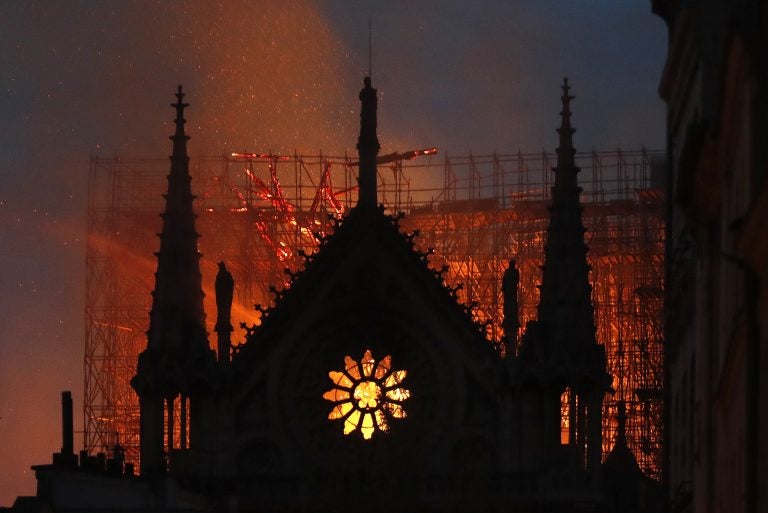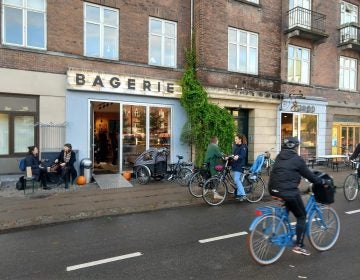Rebuilding from loss in Philadelphia and Paris
The fire at Notre Dame brings our relationship with the buildings we know into sharp, emotional relief.

Flames and smoke rise from Notre Dame cathedral as it burns in Paris, Monday, April 15, 2019. Massive plumes of yellow brown smoke filled the air above Notre Dame Cathedral and ash fell on tourists and others around the island that marks the center of Paris. (Thibault Camus/AP Photo)
Like a lot of people, I spent half a minute on Monday afternoon in stunned silence watching a video of the Notre Dame Cathedral in Paris go up in flames.
For me, the fire isn’t a terribly personal tragedy. I have never been to Notre Dame; I was in Paris one time for a few hours on a layover. My sense of shock lasted only half a minute because, on Twitter, where I first saw the video, the instant commentary started gurgling up right below the image.
This was only a tourist tragedy, someone suggested. Or it was a chance to remake the heart of Paris according to the values of contemporary urbanism. Or, if you are someone who has more to say about the destruction of an old church than the drumbeat of police shootings, then your priorities are sociopathically askew.
Twitter is fine-tuned to elevate these kinds of superficially compelling but ultimately glib reactions to the news of the day. But it is incapable of capturing the potential enormity of this type of loss. The Notre Dame Cathedral hasn’t been completely destroyed, it seems. But even the prospect of its destruction, like the burning of the National Museum of Brazil last fall, will be felt across time, by an entire culture.
Here in Philadelphia, as in all changing cities, we work through a series of far less dramatic but still profound losses all the time. Favorite bars close, churches get demolished, family homes get sold or collapse under the light nudging of an excavator. Every neighborhood and building is constantly reappraised under the spastic logic of the development boom.
To move through time in a city you love is to live in a state of perpetual, low-level mourning. At any one time, you can find yourself at all five stages in the grieving process at once.
I, for example, am currently in denial about a plan to build a parking-lot entrance on 9th Street in the Italian Market along the route of one of my favorite weekly walks. I’m angry about the destruction of Christian Street Baptist Church in favor of expensive townhomes. I’m bargaining over the closure of Penn Book Center. I’m depressed about Little Pete’s (still), and I have mostly reached the phase of acceptance over the demolition of Mt. Sinai Hospital in Pennsport.
By any relative measure, my own grief over losses like these is frivolous. I can always walk on the other side of the street. There are other bookstores, other diners, and for me, Mt. Sinai was just a unique building in a sea of rowhomes just like Christian Street Baptist was an architectural landmark but not a place of worship. And just look at how narrow my corner of the city is. For people with deeper roots, who have forged the identities of their neighborhoods over generations, losses can devastate.
In her book “Root Shock: How Tearing Up City Neighborhoods Hurts America, And What We Can Do About It,” Dr. Mindy Fullilove describes how the upheavals of the 20th century urban renewal period inflicted lasting trauma on urban neighborhoods, including places like Eastwick here in Philadelphia. That trauma is felt by whole communities and lived by individuals.
I think what all these changes have in common — torn-up neighborhoods, world-historical fires, the closing of beloved haunts — is what they reveal about our relationship to our environments.
We inherit our habits and values from the past, and those values are baked into the shape of the city. But the city is not ours, as much as we sometimes feel like it is. Its re-creation is determined by the whims of the real estate market, which we influence at a greater or lesser remove depending on how wealthy we are, through things like city planning.
Losing a familiar piece of the environment feels like losing a part of our identity. Most of those spaces were produced in the service of values that have passed out of favor. As bad as the loss of these places, or worse, is the sense that we aren’t equal partners in deciding what replaces them.
WHYY is your source for fact-based, in-depth journalism and information. As a nonprofit organization, we rely on financial support from readers like you. Please give today.







